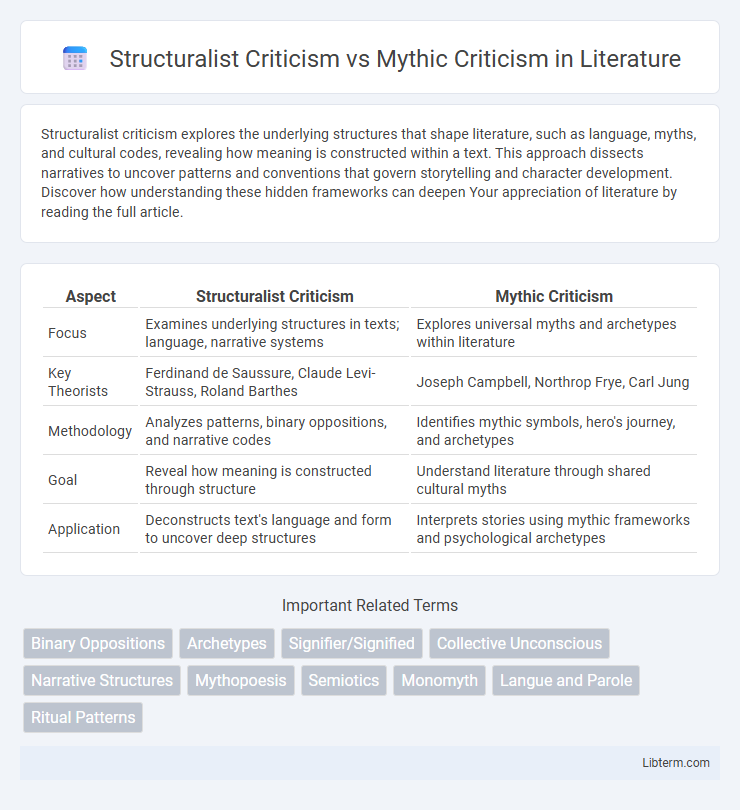Structuralist criticism explores the underlying structures that shape literature, such as language, myths, and cultural codes, revealing how meaning is constructed within a text. This approach dissects narratives to uncover patterns and conventions that govern storytelling and character development. Discover how understanding these hidden frameworks can deepen Your appreciation of literature by reading the full article.
Table of Comparison
| Aspect | Structuralist Criticism | Mythic Criticism |
|---|---|---|
| Focus | Examines underlying structures in texts; language, narrative systems | Explores universal myths and archetypes within literature |
| Key Theorists | Ferdinand de Saussure, Claude Levi-Strauss, Roland Barthes | Joseph Campbell, Northrop Frye, Carl Jung |
| Methodology | Analyzes patterns, binary oppositions, and narrative codes | Identifies mythic symbols, hero's journey, and archetypes |
| Goal | Reveal how meaning is constructed through structure | Understand literature through shared cultural myths |
| Application | Deconstructs text's language and form to uncover deep structures | Interprets stories using mythic frameworks and psychological archetypes |
Introduction to Literary Criticism
Structuralist Criticism analyzes literature by examining underlying structures such as language, narrative patterns, and binary oppositions, emphasizing how these elements create meaning within a text. Mythic Criticism explores universal myths, archetypes, and symbols to interpret literary works, highlighting their connection to collective cultural narratives and human psychology. Both approaches serve as foundational methods in literary criticism, offering distinct frameworks for understanding and interpreting texts.
Defining Structuralist Criticism
Structuralist Criticism analyzes literary texts by examining underlying structures such as language, symbols, and narrative patterns that shape meaning, emphasizing the universal systems governing stories. It identifies binary oppositions and recurring motifs to uncover deep cultural codes embedded within the text. In contrast, Mythic Criticism focuses on archetypal myths and heroic narratives, interpreting literature through shared collective myths and universal symbols.
Fundamentals of Mythic Criticism
Mythic Criticism centers on identifying universal myths and archetypes within literature, emphasizing recurring themes such as the hero's journey and the struggle between good and evil. It draws on the works of scholars like Carl Jung and Joseph Campbell to explore how stories reflect collective unconscious patterns and cultural morals. Unlike Structuralist Criticism, which analyzes narrative structures and language systems, Mythic Criticism focuses on the symbolic meanings and timeless myths that shape human experience.
Historical Development of Both Approaches
Structuralist criticism evolved in the mid-20th century, grounded in the works of Ferdinand de Saussure and Claude Levi-Strauss, focusing on uncovering the underlying structures that shape narratives and cultural phenomena. Mythic criticism, rooted in the early 20th century studies by scholars like Joseph Campbell and Northrop Frye, emphasizes the universal myths and archetypes that recur across different cultures and historical periods. Both approaches developed as responses to formalist criticism, with structuralism prioritizing language systems and mythic criticism concentrating on symbolic meanings embedded in stories throughout history.
Key Theorists and Thinkers
Structuralist criticism primarily revolves around theorists like Ferdinand de Saussure, Claude Levi-Strauss, and Roland Barthes, who emphasize the underlying structures and binary oppositions within texts and cultural phenomena. Mythic criticism is largely influenced by thinkers such as Joseph Campbell and Northrop Frye, who analyze narratives through universal myths, archetypes, and symbolic patterns across cultures. Both approaches explore meaning beyond surface content but differ in focus: structuralist criticism uncovers systems of signs and codes, while mythic criticism decodes timeless mythological motifs.
Comparative Analysis of Core Principles
Structuralist Criticism analyzes literature by examining the underlying structures, such as language systems, binary oppositions, and narrative patterns that shape meaning within texts. Mythic Criticism focuses on identifying universal myths, archetypes, and symbolic motifs that recur across cultures and influence literary works. Both approaches prioritize deep, systematic frameworks, but Structuralism emphasizes linguistic and structural mechanisms, while Mythic Criticism centers on cultural and psychological symbolism in storytelling.
Application in Literary Analysis
Structuralist Criticism analyzes literature by examining underlying structures such as language, narrative patterns, and binary oppositions to uncover meaning and cultural codes within the text. Mythic Criticism focuses on identifying universal myths, archetypes, and symbolic motifs, tracing their recurrence across cultures to interpret deeper psychological and societal themes. Applied in literary analysis, Structuralist Criticism dissects text organization and syntax, while Mythic Criticism contextualizes stories within broader mythological frameworks to reveal timeless human concerns.
Case Studies: Structuralist vs. Mythic Readings
Structuralist criticism dissects literary texts by identifying underlying binary oppositions and deep structures, as seen in Levi-Strauss's analysis of mythic patterns in "Tristes Tropiques." Mythic criticism, exemplified by Northrop Frye's approach in "Anatomy of Criticism," interprets narratives through universal archetypes and recurring mythic themes. Case studies such as Joseph Campbell's exploration of the Hero's Journey reveal mythic frameworks, while Roland Barthes' structuralist readings expose the linguistic codes shaping these myths.
Strengths and Limitations of Each Approach
Structuralist criticism excels in uncovering underlying patterns and binary oppositions within texts, revealing universal structures of meaning, but it may overlook cultural context and individual authorial intent. Mythic criticism strengths lie in identifying archetypal themes and mythical motifs that connect literature to collective human experiences, though it can risk overgeneralization by reducing diverse narratives to common myths. Both approaches offer deep insights into narrative frameworks but require complementary methods to address their contextual and interpretive limitations.
Conclusion: Integrating Perspectives
Structuralist Criticism emphasizes the underlying systems and binary oppositions that shape narratives, revealing how meaning is constructed through universal patterns. Mythic Criticism explores archetypal symbols and myths that resonate across cultures, uncovering the timeless significance embedded in stories. Integrating these perspectives enriches literary analysis by combining the structural framework of texts with the cultural and psychological depths of mythic elements.
Structuralist Criticism Infographic

 libterm.com
libterm.com